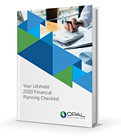What Small Business Owners Need to Know About the New Stimulus Package
By Jesse Giordano, CFP® & Lee Korn | April 24, 2020President Trump just signed the latest coronavirus relief bill, which will funnel more than $320 billion in economic aid to small businesses that have been hit hard by the pandemic. Lawmakers say future legislation is in the works to reinforce these relief efforts. Until then, here’s how the $484 billion bill may affect your finances.

It’s Devoting More Money to Small Businesses
The bill’s most notable details have to do with small businesses. The first round of coronavirus relief was the $2 trillion CARES Act, which passed at the end of March and set aside hundreds of billions for small businesses.
Perhaps the biggest highlight here was the creation of the Paycheck Protection Program (PPP), which provides low-interest loans of up to $10 million to businesses with fewer than 500 employees, including nonprofits and self-employed folks. The icing on the cake is that these loans, which are to be used to cover payroll and other qualifying expenses, are also forgivable if companies meet specific guidelines.
Not surprisingly, the PPP was quickly inundated, and the program ran dry last week after approving over 1.6 million applications in under two weeks—exhausting all of the $349 billion the CARES Act had initially granted. The new bill that was just signed will pump $320 billion back into the PPP. This means that folks who were initially unable to secure a loan will have another chance, which could effectively save many small businesses from going under.
Of this additional funding, roughly $60 billion will be reserved for credit unions, smaller banks and community-based lenders to help unlock funding for businesses that don’t already have banking relationships in place. It’s a move that should help minority-owned businesses and others get the financial help they need.
The bill is also earmarking another $60 billion for the Small Business Administration’s Economic Injury Disaster Loans. The interest rates on these are 3.75% for small businesses; 2.75% for nonprofits. What’s more, these loans that are related to COVID-19 include a forgivable advance of up to $10,000.
An additional benefit is that those who receive a disaster loan can lower their interest rate later on by refinancing it into any PPP loans they end up receiving. (The interest rate on PPP loans is just 1%.)
How Small Businesses Can Apply for These Loans
Given the high demand for these relief loans, it’s best to apply as soon as possible. Here’s how to do it.
- Applying for a Paycheck Protection Program Loan: Fill out this application form, then find an SBA-approved lender here. The Washington Post reports that it’s best to apply by phone or online. All applicants who haven’t yet established a banking relationship will be processed on a first-come, first-served basis.
- Applying for an SBA Economic Injury Disaster Loan: As of April 24th, the Small Business Administration was unable to accept new applications due to available appropriations funding. In other words, it’s temporarily on hold, but we’re assuming that will change as soon as funding comes through from the latest relief bill. The application will be here when it becomes available.
Additional Funds Are Reserved for Hospitals and COVID-19 Testing
The new bill is directing an extra $75 billion to hospitals and $25 billion more to expand COVID-19 testing. This includes researching, developing, validating, manufacturing, purchasing and administering coronavirus tests. $11 billion of these funds will make its way to states and local governments, while the rest will be directed to federal agencies and other entities exploring new ways to combat the pandemic. A significant detail of the bill is that is requires a national testing strategy to guide states, which includes how the money should be used for testing.
At the time of this writing, the Johns Hopkins University COVID-19 tracker reports that 890,524 people in the U.S. have tested positive for coronavirus. The encouraging news is that dozens of states are indeed flattening the curve locally. Meanwhile, some states are making plans to gradually move forward with a phased reopening of their economies.
There are still a lot of unknowns, but that doesn’t mean we’re powerless. Our country is moving in the right direction in terms of economic recovery and public health. And while things may not be back to normal yet, Opal Wealth Advisors is using this time to work with clients on an individual basis to help them make the best decisions for their investment portfolios. We’ll continue to provide up-to-date insights on what COVID-19 means for you, your family, and your business. Drop us a note if you would like to discuss your situation and how it may be affected by this round of stimulus relief.
Be a Smart Investor
Stay up-to-date with industry-leading information and news delivered straight to your inbox.
Get our timely insights delivered to your inbox (Blog)
Please remember that past performance may not be indicative of future results. Different types of investments involve varying degrees of risk, and there can be no assurance that the future performance of any specific investment, investment strategy, or product (including the investments and/or investment strategies recommended or undertaken by Opal Wealth Advisors, LLC [“OWA]), or any non-investment related content, made reference to directly or indirectly in this commentary will be profitable, equal any corresponding indicated historical performance level(s), be suitable for your portfolio or individual situation, or prove successful. Due to various factors, including changing market conditions and/or applicable laws, the content may no longer be reflective of current opinions or positions. Moreover, you should not assume that any discussion or information contained in this commentary serves as the receipt of, or as a substitute for, personalized investment advice from OWA. OWA is neither a law firm, nor a certified public accounting firm, and no portion of the commentary content should be construed as legal or accounting advice. A copy of the OWA’s current written disclosure Brochure discussing our advisory services and fees continues to remain available upon request or at www.opalwealthadvisors.com. Please Remember: If you are a OWA client, please contact OWA, in writing, if there are any changes in your personal/financial situation or investment objectives for the purpose of reviewing/evaluating/revising our previous recommendations and/or services, or if you would like to impose, add, or to modify any reasonable restrictions to our investment advisory services. Unless, and until, you notify us, in writing, to the contrary, we shall continue to provide services as we do currently. Please Also Remember to advise us if you have not been receiving account statements (at least quarterly) from the account custodian.



